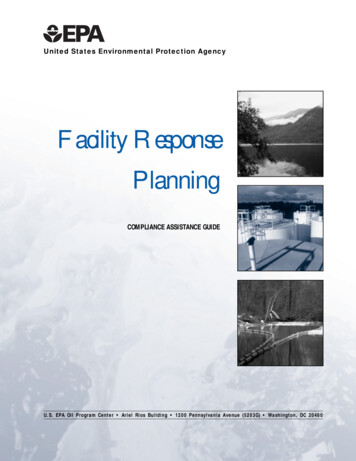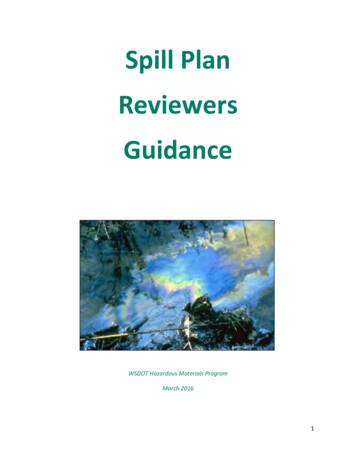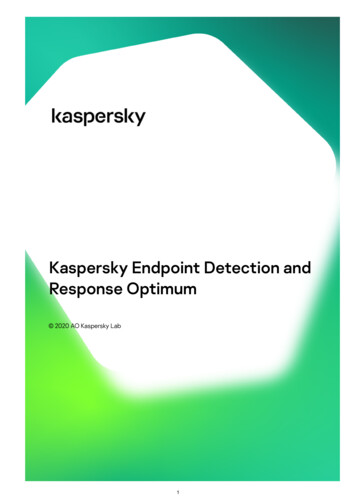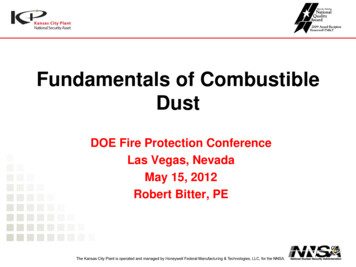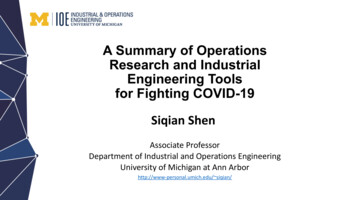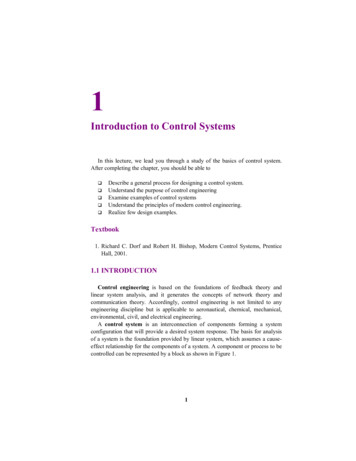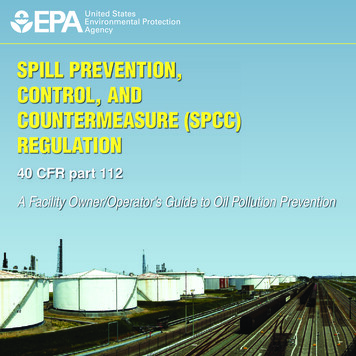
Transcription
SPILL PREVENTION,CONTROL, ANDCOUNTERMEASURE (SPCC)REGULATION40 CFR part 112A Facility Owner/Operator’s Guide to Oil Pollution Prevention
authority of Section 311(j)(1)(C) of the Federal WaterPollution Control Act (Clean Water Act) in 1974.The rule may be found at Title 40, Code of FederalRegulations, Part 112.1. Who is covered by the SPCC Rule?A facility is covered by the SPCC rule if it has anaggregate aboveground oil storage capacity greaterthan 1,320 U.S. gallons or a completely buriedstorage capacity greater than 42,000 U.S. gallons andthere is a reasonable expectation of an oil dischargeinto or upon navigable waters of the U.S. or adjoiningshorelines.OIL POLLUTION PREVENTIONOil spills endanger public health, impact drinkingwater, devastate natural resources, and disruptthe economy. In the United States we use vastquantities of oils to heat our homes, provide fuelfor automobiles, and operate various pieces ofequipment. During storage, transport, or as the resultof energy exploration and production activities, oiland other oil-based products are sometimes spilledonto land or into waterways. When this occurs,human health and environmental quality are put atrisk. Every effort must be made to prevent oil spillsand to clean them up promptly once they occur. Thecosts associated with spill prevention are often muchless than the costs associated with spill clean up,fines, and other civil liabilities. As the old adagestates, “an ounce of prevention is worth a pound ofcure.”2. What types of oil are covered?Oil of any type and in any form is covered, including,but not limited to: petroleum; fuel oil; sludge; oilrefuse; oil mixed with wastes other than dredgedspoil; fats, oils or greases of animal, fish, or marinemammal origin; vegetable oils, including oil fromseeds, nuts, fruits, or kernels; and other oils andgreases, including synthetic oils and mineral oils.The purpose of the Spill Prevention, Control, andCountermeasure (SPCC) rule is to help facilitiesprevent a discharge of oil into navigable watersor adjoining shorelines. This rule is part of theU.S. Environmental Protection Agency’s oil spillprevention program and was published under the2
3. What kinds of facilities are covered?A facility that stores, processes, refines, uses or consumes oil and is non-transportation-related ispotentially subject to the SPCC rule. Operations that are intended to move oil from one location to another,i.e. transportation-related, are not included. Here are some examples of covered facilities and operations:Oil Drilling Onshore and offshore oil well drilling facilities; Onshore and offshore oil production facilities (includingseparators and storage facilities); Oil refining or storage facilities; Industrial, commercial, agricultural, or public facilities usingor storing oil; Certain waste treatment facilities; Loading racks, transfer hoses, loading arms, and otherequipment; Vehicles (e.g. tank trucks) and railroad cars used to transportoil exclusively within the confines of a facility; and Pipeline systems used to transport oil exclusively within theconfines of a facility.Power GeneratorsOil ProductionOil StorageWhat kinds of activities are typically notcovered?Here are some examples of transportation-related activities orequipment typically not covered by the SPCC rule:Oil RefineriesAirports Interstate or inter-facility oil pipeline systems Oil transported in vessels (e.g. ships, barges) Oil transported between facilities by rail car or tanker truckMarinasFish Canneries3Power Transmissionand DistributionConstruction SitesFarms and Ranches
4. How do I calculate oilstorage capacity?or other equipment used in the alteration, processingor refining of crude oil and other non-petroleum oils,including animal fats and vegetable oils.Use the shell capacity of the container (maximumvolume) and not the actual amount of product storedin the container (operational volume) to determinewhether the SPCC rule applies to you. Count onlycontainers with storage capacity equal to or greaterthan 55 U.S. gallons.5. How do I determine if my facilitycould reasonably discharge oil intoor upon navigable waters or adjoiningshorelines?Simply add up the container oil storage capacities andcompare your total facility capacity to the SPCC threshold: A total aboveground oil storage capacity greater than1,320 U.S. gallons; or A completely buried oil storage capacity greater than42,000 U.S. gallons.Examples of oil storage containers at a facility thatdo count toward facility storage capacity:Bulk storage containers: Aboveground storagetanks (either shop-built or field-erected tanks); certaincompletely buried tanks; partially buried tanks; tanksin vaults; bunkered tanks; and mobile or portablecontainers such as drums, totes, non-transportation related tank trucks, and mobile refuelers.You can determine this by considering the geographyand location of your facility relative to nearbynavigable waters (such as streams, creeks and otherwaterways). Additionally, you should determineif ditches, gullies, storm sewers or other drainagesystems may transport an oil spill to nearby streams.Estimate the volume of oil that could be spilled in anincident and how that oil might drain or flow fromyour facility and the soil conditions or geographicfeatures that might affect the flow toward waterways.Also you may want to consider whether precipitationrunoff could transport oil into navigable waters oradjoining shorelines. You may not take into accountmanmade features, such as dikes, equipment, orOil-filled equipment: May include electrical oroperating equipment such as hydraulic systems,lubricating systems (e.g., those for pumps,compressors and other rotating equipment, includingpumpjack lubrication systems), gear boxes,machining coolant systems, heat transfer systems,transformers, circuit breakers, and electrical switches;or manufacturing equipment such as process vessels,4
Periodically inspecting and testing pipesand containers. You need to visually inspectaboveground pipes and oil containers accordingto industry standards; buried pipes need to be leaktested when they are installed or repaired. Include awritten record of inspections in the Plan.other structures that might prevent, contain,hinder, or restrain the flow of oil. Assume thesemanmade features are not present when makingyour determination. If you consider the applicablefactors described above and determine a spill canreasonably flow to a waterway, then you mustcomply with the SPCC rule.Prepare and implement an SPCC Plan: The owner oroperator of the facility must develop and implementan SPCC Plan that describes oil handling operations,spill prevention practices, discharge or drainagecontrols, and the personnel, equipment and resourcesat the facility that are used to prevent oil spills fromreaching navigable waters or adjoining shorelines.Although each SPCC Plan is unique to the facility,there are certain elements that must be described inevery Plan including:6. What do covered facilities haveto do?A facility that meets the criteria described abovemust comply with the SPCC rule by preventing oilspills and developing and implementing an SPCCPlan.Prevent oil spills: Steps that a facility owner/operator can take to prevent oil spills include: Using containers suitable for the oil stored. Forexample, use a container designed for flammableliquids to store gasoline; Providing overfill prevention for your oil storagecontainers. You could use a high-level alarm oraudible vent; Providing sized secondary containment for bulkstorage containers, such as a dike or a remoteimpoundment. The containment needs to holdthe full capacity of the container plus possiblerainfall. The dike may be constructed of earth orconcrete. A double-walled tank may also suffice; Providing general secondary containment tocatch the most likely oil spill where you transferoil to and from containers and for mobilerefuelers and tanker trucks. For example, youmay use sorbent materials, drip pans or curbingfor these areas; and Operating procedures at the facility to prevent oilspills; Control measures (such as secondary containment)installed to prevent oil spills from enteringnavigable waters or adjoining shorelines; and Countermeasures to contain, cleanup, and mitigatethe effects of an oil spill that has impactednavigable waters or adjoining shorelines.Did you know?A spill of only one gallonof oil can contaminatea million gallons of water.5
7. Who can certify the SPCC Plan?Every SPCC Plan must be prepared in accordancewith good engineering practices. Every SPCC Planmust be certified by a Professional Engineer unlessthe owner/operator is able to, and chooses to, selfcertify the Plan (see section 7).Preparation of the SPCC Plan is the responsibilityof the facility owner or operator, who may also beeligible to self-certify the SPCC Plan if the facilitymeets the following eligibility criteria for a qualifiedfacility:No matter who certifies your SPCC Plan, rememberthat ultimately the owner or operator is responsiblefor complying with the rule. A copy of the rule isavailable at www.epa.gov/oilspill. You may also callor write to the nearest EPA office listed in section 11.1. Total aboveground oil storage capacity of 10,000U.S. gallons or less, and2. In the 3 years prior to the date the SPCC Plan iscertified, the facility has had no single dischargeof oil to navigable waters or adjoining shorelinesexceeding 1,000 U.S. gallons, or no two dischargesof oil to navigable waters or adjoining shorelineseach exceeding 42 U.S. gallons within any12-month period.1Important Elements of an SPCC Plan: Facility diagram and description of the facility Oil discharge predictions Appropriate secondary containment or diversionarystructures Facility drainage Site security Facility inspections Requirements for bulk storage containers includinginspections, overfill, and integrity testing requirements Transfer procedures and equipment (including piping) Requirements for qualified oil-filled operational equipment Loading/unloading rack requirements and procedures fortank cars and tank trucks Brittle fracture evaluations for aboveground fieldconstructed containers Personnel training and oil discharge prevention briefings Recordkeeping requirements Five-year Plan review Management approval Plan certification (by a Professional Engineer (PE) or incertain cases by the facility owner/operator)If the facility does not meet the above criteria,the SPCC Plan must be certified by a licensedProfessional Engineer (PE). By certifying the SPCCPlan, the PE confirms that:1. He is familiar with the requirements of the rule;2. He or an agent has visited and examined thefacility;3. The SPCC Plan has been prepared in accordancewith good engineering practices, includingconsideration of applicable industry standards, andwith the requirements of the rule;1Not including discharges that are the result of natural disasters, acts ofwar, or terrorism. When determining the applicability of this SPCC reportingrequirement, the gallon amount(s) specified (either 1,000 or 42) refers to theamount of oil that actually reaches navigable waters or adjoining shorelinesnot the total amount of oil spilled. EPA considers the entire volume of thedischarge to be oil for the purposes of these reporting requirements.6
You may present additional oral or written statementsin support of your extension request. The extensionrequest does not relieve you of your obligation tocomply with the requirements of the rule. The RAWhen self-certifying a facility’s SPCC Plan, themay request a copy of your SPCC Plan to evaluate theowner/operator makes a similar statement. See §112.6 extension request.of the rule for other qualified facility SPCC PlanIf the RA approves an extension of time for particularrequirements.equipment or other specific aspects of the SPCC Plan,you must still comply with SPCC requirements not8. How do I ask for an extension ofcovered by the extension.4. Procedures for required inspections and testinghave been established; and5. The SPCC Plan is adequate for the facility.time to prepare and implement anSPCC Plan?9. Do I need to submit the SPCC Planto EPA?If you are unable to prepare or amend and fullyimplement your SPCC Plan by the compliance datedue to either non-availability of qualified personnel,or delays in construction or equipment deliverybeyond the control of the owner or operator, then youmay request an extension from your EPA RegionalAdministrator (RA). A list of EPA Regional Offices isavailable in section 11.No, SPCC Plans should be maintained at any facilitynormally attended at least four hours per day or atthe nearest field office if the facility is not so staffed.Submit your Plan to EPA only when requested.10. What should I do if I have a spill?If your facility discharges oil to navigable watersor adjoining shorelines, you are required to followcertain federal reporting requirements. Any person incharge of an onshore or offshore facility must notifythe National Response Center (NRC) immediatelyafter he or she has knowledge of the discharge.Oil discharges that reach navigable waters must bereported to the NRC at 1-800-424-8802 or 1-202 426-2675. The NRC is the federal government’scentralized reporting center, which is staffed 24 hoursper day by U.S. Coast Guard personnel.Submit a written request for an extension to your RA.Your request must include: A full explanation of the cause for any such delayand the specific aspects of the SPCC Plan affectedby the delay; A full discussion of actions being taken orcontemplated to minimize or mitigate such delay;and A proposed time schedule for the implementationof any corrective actions being taken orcontemplated, including interim dates forcompletion of tests or studies, installation andoperation of any necessary equipment, or otherpreventive measures.A common misunderstanding is that by reportingto the NRC you have met state and local reportingrequirements. The report to the NRC only satisfiesyour federal reporting requirements under the Clean7
After the NRC has been notified, the owner/operatormust provide the following information to the RA: Name and location of the facility Owner/operator name Maximum storage/handling capacity of the facilityand normal daily throughput Corrective actions and countermeasures taken,including descriptions of equipment repairs andreplacements Adequate description of the facility, includingmaps, flow diagrams, and topographical maps, asnecessary Cause of the discharge to navigable waters,including a failure analysis Failure analysis of the system where the dischargeoccurred Additional preventive measures taken or planned totake to minimize discharge reoccurrenceWater Act. Additional state and local reportingrequirements may apply. In most cases it makessense to call 911 in the event of an oil spill,particularly in the case of flammable or combustibleoil spillsAny owner or operator of a facility regulated by theSPCC rule must also report the discharge to EPAwhen: More than 1,000 U.S. gallons of oil is discharged tonavigable waters or adjoining shorelines in a singleevent; or More than 42 U.S. gallons of oil in each of twodischarges to navigable waters or adjoiningshorelines occurs within any twelve-month period.The RA may require additional information. You mustalso send a copy of this information to the agency oragencies in charge of oil pollution control activitiesin the state in which the SPCC-regulated facility islocated.Note: The gallon amount(s) specified (either 1,000 or42) refers to the amount of oil that actually reachesnavigable waters or adjoining shorelines, not thetotal amount of oil spilled. EPA considers the entirevolume of the discharge to be oil for the purposes ofthese reporting requirements.8
11. Who should I contact for more information? Visit the Office of Emergency Management’s Web site at www.epa.gov/emergencies. See the Government Printing Office website at www.gpoaccess.gov/cfr to access the current CFR. See the SPCC Guidance for Regional Inspectors for more detailed guidance on specific SPCC provisions, athttp://www.epa.gov/emergencies/content/spcc/spcc guidance.htm.Call our hotline, the Superfund, TRI, EPCRA, RMP, and Oil Information Center(800) 424-9346 or (703) 412-9810 TDD (800) 553-7672 or (703) 412-3323(Mon-Thurs 10:00 am to 3:00 pm ET except Federal Holidays) or r/index.htmYou can also call or write:U.S. EPA HeadquartersOffice of Emergency ManagementAriel Rios Building – Mail Code 5104A1200 Pennsylvania AvenueWashington, DC 20460202-564-8600U.S. EPA Region I5 Post Office Square, Suite 100Boston, MA 02109-3912617-918-1111CT, ME, MA, NH, RI, and VTU.S. EPA Region II2890 Woodbridge AvenueBuilding 209 (MS211)Edison, NJ 08837-3679732-321-6654NJ, NY, PR, and USVIU.S. EPA Region III1650 Arch Street (3HS61)Philadelphia, PA 19103-2029800-438-2474DE, DC, MD, PA, VA, and WVU.S. EPA Region IV61 Forsyth StreetAtlanta, GA 30365-3415404-562-9900AL, FL, GA, KY, MS, NC, SC, and TNU.S. EPA Region VIII1595 Wynkoop Street (8EPR-ER)Denver, CO 80202-1129800-227-8917CO, MT, ND, SD, UT, and WYU.S. EPA Region V77 West Jackson Boulevard (SE-5J)Chicago, IL 60604-3590312-353-2000IL, IN, MI, MN, OH, and WIU.S. EPA Region IX75 Hawthorne Street (SFD-9-4)San Francisco, CA 94105415-972-3052 or 415-972-3089AZ, CA, HI, NV, AS, and GUU.S. EPA Region VI1445 Ross Avenue (6SF-RO)Dallas, TX 75202-2733214-665-6444AR, LA, NM, OK, and TXU.S. EPA Region X1200 6th Avenue (ECL-116)Seattle, WA 98101800-424-4372AK, ID, OR, and WAU.S. EPA Region VII901 North 5th StreetKansas City, KS 66101913-551-7050IA, KS, MO, and NEU.S. EPA Alaska Operations Office222 West 7th Avenue, #19Anchorage, AK 99513-7588907-271-5083To report an oil or chemical spill, call the National Response Center at (800) 424-8802.9
Recycled/RecyclablePrinted on paper that contains at least 20% recycled fiberUnited States EnvironmentalProtection AgencyOffice of Solid Waste andEmergency ResponseEPA 540-K-09-001June 2010
SPILL PREVENTION, CONTROL, AND COUNTERMEASURE (SPCC) REGULATION 40 CFR part 112 A Fa
